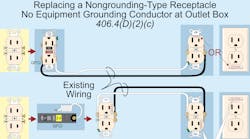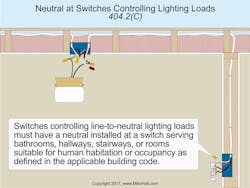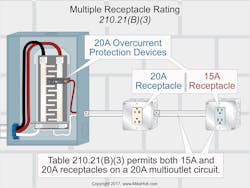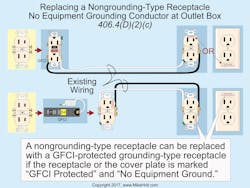Switches controlling line-to-neutral loads must have a neutral conductor installed at a switch serving bathrooms, hallways, stairways, or rooms suitable for human habitation or occupancy, as defined in the applicable building code [404.2(C)] (Fig. 1).
When wiring for 3-way and 4-way switches, only the ungrounded conductors are switched [404.2(A)]. The neutral conductor must not be switched. New with the 2017 NEC: Where 3-way and 4-way switches are visible in a room, only one of the switches requires a neutral conductor.
A neutral conductor isn’t required under any of the conditions enumerated in Sec. 404.2(C)(1) through (5). For example, it’s not required for switches controlling receptacles.
A requirement that’s new with the 2017 NEC is the neutral conductor must be run to any replacement switch that requires line-to-neutral voltage [404.22] to operate in standby mode. That neutral completes the circuit for electronic lighting control devices that require a neutral conductor. The connection requirements become effective Jan. 1, 2020.
A neutral conductor isn’t required for replacement switches in locations wired prior to the adoption of 404.2(C) where the neutral conductor can’t be extended without removing finish materials. The number of electronic lighting control switches without a neutral conductor on a branch circuit must not exceed five. The number connected to any feeder must not exceed 25 [404.2(C) Exception].
Damp or wet locations
Surface-mounted switches and circuit breakers in a damp or wet location must be in a weatherproof enclosure [404.4(A)]. You need at least ¼ in. of airspace between the enclosure and the wall or other supporting surface [312.2].
A flush-mounted switch or circuit breaker in a damp or wet location must have a weatherproof cover [404(B)].
Switches can be next to but not within a bathtub, hydromassage bathtub, or shower space unless installed as part of a listed tub or shower assembly [404.4(C)].
Indicating
Switches, motor circuit switches, and circuit breakers used as switches must be marked to indicate their ON or OFF position [404.7]. When the switch is operated vertically, it must be installed so the “up” position is the ON position [240.81].
Two exceptions:
(1) Double-throw switches (e.g., 3-way and 4-way switches) aren’t required to be marked ON or OFF.
(2) On busway installations, tap switches employing a center-pivoting handle can be open or closed with either end of the handle in the up or down position. The switch position must be clearly indicated visible from the floor or from the usual point of operation.
Faceplates
Switch faceplates must completely cover the outlet box opening and, where flush mounted, seat against the wall surface [404.9(A)].
The metal mounting yokes for switches, dimmers, etc., must connect to an equipment grounding conductor (EGC) [404.9(B)]. New with the 2017 NEC: Metal faceplates must connect to an EGC.
Electronic lighting switches. Effective Jan. 1, 2020, electronic lighting control switches must be listed to not introduce current on the EGC during normal operation [404.22]. New with the 2017 NEC: Electronic lighting control switches that put current on the EGC [404.2(C) Exception] must be listed and marked for use only for replacement or retrofit applications.
Receptacle general installation requirement
Receptacles must be installed on circuits for which they’re rated, except as permitted in Table 210.21(B)(2) and Table 210.21(B)(3) (Fig. 2).
Receptacles installed on 15A and 20A branch circuits must be of the grounding type unless used for replacements as permitted in 406.4(D)(2) [406.4(A)]. Grounding contacts for receptacles must connect to an EGC supplied with the branch-circuit wiring [406.4(C)].
If an EGC exists in the outlet box, grounding-type receptacles must replace nongrounding-type receptacles, and the receptacle’s grounding terminal must connect to the circuit EGC per Sec. 250.130(C) or Sec. 406.4(C).
If an EGC doesn’t exist in the outlet box, then you can replace the existing nongrounding-type receptacle with one of the following [406.4(D)(2)]:
- Nongrounding-type receptacle.
- GFCI-type receptacle with the receptacle or cover plate marked “No Equipment Ground.”
- GFCI-protected grounding-type receptacle with the receptacle or cover plate (“cover plate” added with the 2017 NEC) marked “GFCI Protected” and “No Equipment Ground.” New with the 2017 NEC: The marking must be visible after installation (Fig. 3).
New with the 2017 NEC: New Informational Notes 1 and 2 point out that a nongrounding type receptacle isn’t permitted where equipment instructions or Sec. 250.114 require an EGC.
The permission to replace nongrounding-type receptacles with GFCI-protected grounding-type receptacles doesn’t apply to new receptacle outlets that extend from an existing outlet box that’s not connected to an EGC. Once you add a receptacle outlet (branch-circuit extension), the receptacle must be of the grounding type and its grounding terminal must connect to an EGC of a type recognized in Sec. 250.118 per Sec. 250.130(C).
Where a receptacle outlet is in an area that requires AFCI protection per Sec. 210.12, the replacement receptacle(s) must be one of the following [406.4(D)(4)]:
(1) Listed AFCI receptacle.
(2) Receptacle protected by a listed AFCI receptacle.
(3) Receptacle protected by an AFCI circuit breaker.
New with the 2017 NEC: Exception 1: AFCI protection for receptacles isn’t required where all of the following apply:
(1) The replacement receptacle is of the GFCI type per Sec. 406.4(D)(2)(b).
(2) It’s impracticable to provide an EGC per Sec. 250.130(C).
(3) A listed combination type AFCI circuit breaker isn’t commercially available for the panelboard.
(4) A listed dual function GFCI/AFCI receptacle isn’t commercially available.
Mounting
Receptacles must be installed in identified outlet boxes that are securely fastened in place per Sec. 314.23 [406.5].
Receptacles in outlet boxes that are:
- Set back from the finished surface (as permitted by 314.20) must be installed so the receptacle mounting yoke is held rigidly to the finished surface or outlet box.
- Flush with the finished surface must be installed so the receptacle mounting yoke is held rigidly against the outlet box or raised box cover.
Receptacles supported by a cover must be held rigidly to the cover with at least two screws [406.5(C)]. Receptacles must be flush with, or project from, faceplates [406.5(D)].
New with the 2017 NEC: the following must be listed for countertop applications:
Receptacle assemblies installed in countertop surfaces [406.5(E)].
Receptacle assemblies and GFCI assemblies installed in a work surface [406.5(F)] (or can be listed for work surface applications).
Receptacles installed in a face-up position in countertop surfaces or work surfaces (or can be listed for work surface applications). [406.5(G)].
Receptacles can’t be installed in a face-up position in seating areas or similar surfaces, unless the receptacle is [406.5(H)]:
(1) Part of a listed furniture power distribution unit,
(2) Part of a listed furnishing,
(3) Listed for use in countertops, or
(4) Installed in a listed floor box.
New with the 2017 NEC: Cover plates that provide night light and/or Class 2 output connector(s) must be listed and constructed so the night light and/or Class 2 circuitry is integral with the cover plate [406.6(D)].
Damp or wet locations
Receptacles in a damp location must be installed in an enclosure that’s weatherproof when an attachment plug cap isn’t inserted, and the receptacle cover is closed, or an enclosure that’s weatherproof when an attachment plug is inserted [406.9(A)]. Nonlocking 15A and 20A, 125V and 250V receptacles in a damp location must be listed as weather resistant.
15A and 20A receptacles in a wet location must be within an enclosure that’s weatherproof when an attachment plug is inserted using an outlet box hood identified as “extra duty” [406.9(B)(1)]. Nonlocking-type 15A and 20A, 125V and 250V receptacles in a wet location must be listed as the weather-resistant type.
Receptacles rated 30A or more installed in a wet location must comply with (a) or (b) [406.9(B)(2)]:
a. Where the load isn’t attended while in use, install the receptacle in an enclosure that’s weatherproof when an attachment plug is inserted.
b. Where the receptacle will be used only while someone is near it (e.g., one used with portable tools), it can have an enclosure that’s weatherproof when the attachment plug is removed and the cover is closed.
The enclosure for a receptacle installed in an outlet box that’s flush-mounted on a finished surface must be made weatherproof by a weatherproof faceplate that provides a watertight connection between the plate and finished surface [406.9(E)].
Avoiding violations
Code violations in switch and receptacle installations typically involve mounting errors and “grounding” (connecting to the EGC) errors. New requirements for “smart switches” could see “neutral wire” errors turn that duo into a trio. To avoid violations in your installations, review these common “areas of error” before calling the job complete.
These materials are provided to us by Mike Holt Enterprises in Leesburg, Fla. To view Code training materials offered by this company, visit www.mikeholt.com/code.







